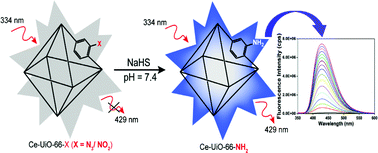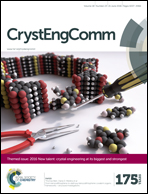Cerium-based azide- and nitro-functionalized UiO-66 frameworks as turn-on fluorescent probes for the sensing of hydrogen sulphide†
Abstract
A new and an existing Ce-based metal–organic framework (MOF) having a UiO-66 framework topology and incorporating azide and nitro functional groups in their frameworks have been successfully used as turn-on fluorescent probes for the sensing of H2S under physiological conditions. The azide (1-N3) and nitro (2-NO2) functionalized Ce MOFs have been synthesized under similar solvothermal conditions (100 °C, 15 min) using ammonium cerium(IV) nitrate and H2BDC-X (BDC = 1,4-benzenedicarboxylate; X = –N3 for 1-N3 and –NO2 for 2-NO2) linkers in DMF/H2O (DMF = N,N-dimethylformamide) mixtures. The phase purity of both compounds has been confirmed by X-ray powder diffraction (XRPD) analyses, infrared spectroscopy and thermogravimetric (TG) analyses. The thermally activated forms of both compounds (1′-N3 and 2′-NO2) show fast response time, excellent selectivity and sensitivity for the detection of H2S under physiological conditions (HEPES buffer, pH 7.4) through the fluorescence ‘turn-on’ mechanism. The detection limits (12.2 μM for 1′-N3 and 34.8 μM for 2′-NO2) of both materials lie within the range of the H2S concentration observed in biological systems. The materials can selectively detect H2S even in the presence of other competing biomolecules. Apart from the sensing of H2S, both compounds exhibit high uptake of CO2 (2.6 mmol g−1 for 1′-N3 and 3.7 mmol g−1 for 2′-NO2) at 0 °C and 1 bar. Thus, the materials are promising candidates in the fields of H2S sensing and CO2 capture.

- This article is part of the themed collection: 2016 New talent

 Please wait while we load your content...
Please wait while we load your content...